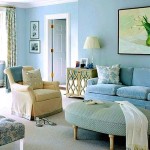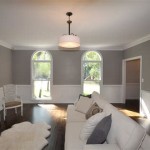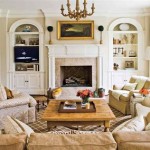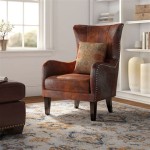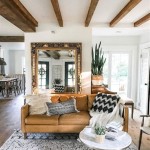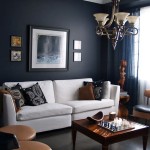Interior Design Strategies for Small Living Rooms
Designing a small living room presents unique challenges. Maximizing functionality and creating a visually appealing space requires careful consideration of layout, furniture selection, color palettes, and storage solutions. Overcrowding can quickly make a small room feel claustrophobic, while a sparse design can feel unwelcoming. The key is to strike a balance between practicality and aesthetics, creating a comfortable and stylish area that serves as the central gathering space in the home.
Effective small living room design hinges on understanding the limitations of the space and employing strategies that enhance its perceived size. This involves optimizing natural light, utilizing vertical space, and choosing furniture pieces that are proportionate to the room's dimensions. Furthermore, a cohesive design scheme is crucial for creating a sense of harmony and preventing the room from feeling disjointed. A well-planned living room, regardless of its size, can be both functional and visually appealing.
Optimizing Space with Multifunctional Furniture
One of the most effective strategies for maximizing space in a small living room is to incorporate multifunctional furniture. These pieces serve multiple purposes, reducing the need for additional items and freeing up valuable floor space. Common examples include sofa beds, storage ottomans, and coffee tables with built-in drawers or shelves. A sofa bed provides seating during the day and transforms into a comfortable bed for guests, eliminating the need for a separate guest room. Storage ottomans offer a place to rest feet and store blankets, pillows, or books. A coffee table with storage can conceal clutter and keep the room organized.
When selecting multifunctional furniture, it's essential to consider its size and design. Opt for pieces that are proportionate to the room's dimensions and complement the overall aesthetic. Avoid bulky or oversized items that can overwhelm the space. Instead, choose sleek and streamlined designs that blend seamlessly into the room. Consider the materials and finishes as well. Light-colored furniture can help to brighten the room and create a sense of spaciousness, while darker colors can add depth and sophistication.
Another useful tip is to look for furniture with hidden storage compartments. For example, a storage bench can provide seating and storage, while a wall-mounted cabinet can offer a place to store books or decorative items without taking up floor space. These hidden storage solutions can help to keep the room clutter-free and organized, making it feel more spacious and inviting.
Beyond traditional multifunctional furniture, consider adaptable shelving units. These can be configured to hold various items, from books and decorative objects to media equipment. Choose a unit that can be easily adjusted to accommodate changing needs. Wall-mounted shelves are an excellent option for small living rooms, as they utilize vertical space and don't take up valuable floor area. Ensure that shelves are securely mounted and can support the weight of the items they will hold.
Finally, consider the flexibility of your furniture arrangement. Opt for pieces that can be easily moved and rearranged to suit different activities. For example, lightweight chairs can be easily moved around the room to accommodate guests or create a more intimate seating area. A coffee table on wheels can be easily moved out of the way when needed. This flexibility can help to make the room more adaptable and functional.
Enhancing Perceived Space Through Color and Light
Color and light play a crucial role in creating the illusion of space in a small living room. Light colors tend to reflect more light, making the room feel brighter and more open, while dark colors can absorb light and make the room feel smaller and more enclosed. Therefore, it's generally recommended to use light and neutral colors on the walls, such as white, cream, beige, or light gray. These colors can create a sense of spaciousness and airiness.
While light colors are generally preferred, that doesn't mean that dark colors should be avoided altogether. Darker shades can be used strategically to add depth and visual interest to the room. For example, an accent wall in a dark color can create a focal point and add drama, while dark-colored accessories can add contrast and sophistication. The key is to use dark colors sparingly and balance them with lighter colors to prevent the room from feeling too dark or enclosed.
In addition to wall colors, consider the color of the furniture and accessories. Light-colored furniture can help to brighten the room and create a sense of spaciousness, while darker furniture can add depth and contrast. Aim for a balanced color scheme that incorporates a mix of light and dark colors. For example, a light-colored sofa can be paired with dark-colored cushions or throws.
Natural light is another crucial element in creating a sense of spaciousness. Maximize the amount of natural light that enters the room by keeping windows clean and uncluttered. Avoid heavy curtains or blinds that can block out light. Instead, opt for sheer curtains or blinds that allow light to filter through while still providing privacy. Mirrors can also be used to reflect light and create the illusion of more space.
Artificial lighting is also important, especially in rooms that don't receive a lot of natural light. Layered lighting is an effective strategy for creating a warm and inviting atmosphere. This involves using a combination of ambient lighting, task lighting, and accent lighting. Ambient lighting provides overall illumination, task lighting provides focused light for specific activities, and accent lighting highlights decorative features. Use floor lamps, table lamps, and recessed lighting to create a layered lighting scheme that enhances the room's functionality and aesthetics.
Creating Visual Interest with Focal Points and Accessories
Even in a small living room, creating visual interest is essential for making the space feel inviting and stylish. Focal points help to draw the eye and create a sense of balance and harmony. A focal point can be anything from a fireplace or a large window to a piece of artwork or a decorative mirror. The key is to choose a focal point that is visually appealing and complements the overall design scheme.
Once a focal point has been established, arrange the furniture and accessories to draw attention to it. For example, a sofa can be placed facing the fireplace, and a coffee table can be centered in front of the sofa. Artwork can be hung above the fireplace or on a nearby wall. The goal is to create a visually appealing arrangement that highlights the focal point and creates a sense of balance.
Accessories play a critical role in adding personality and visual interest to a small living room. However, it's important to avoid cluttering the space with too many accessories. Instead, choose a few carefully selected items that complement the overall design scheme and add a personal touch. Common accessories include cushions, throws, rugs, artwork, plants, and decorative objects.
Cushions and throws can add color, texture, and comfort to a sofa or armchair. Choose cushions and throws that complement the color scheme and add a layer of visual interest. Rugs can define a seating area and add warmth and texture to the floor. Choose a rug that is appropriately sized for the room and complements the overall design scheme.
Artwork can express personal style and add visual interest to the walls. Choose artwork that is appropriately sized for the room and complements the overall design scheme. Plants can add life and freshness to a small living room. Choose plants that are well-suited to the lighting conditions and complement the overall design scheme. Consider vertical planters to maximize space and add green to the room.

10 Stunning Small Living Room Ideas To Maximize Space

31 Stunning Small Living Room Ideas

Small Living Room Decorating Ideas For A Stylish Space

25 Small Apartment Living Room Ideas For A Cozy Home Makeover

10 Must Try Modern Living Room Design Ideas

25 Small Apartment Living Room Ideas For A Cozy Home Makeover

Small Living Room Decorating Ideas 5 Tips To Open Up Your Space

Top 10 Ideas On How To Decorate A Small Living Room Decorilla Online Interior Design

How To Decorate A Small Living Room That Works For Entertaining And Everyday Lounging Gal At Home Design Studio

120 Living Room Designs Interiors Designcafe

